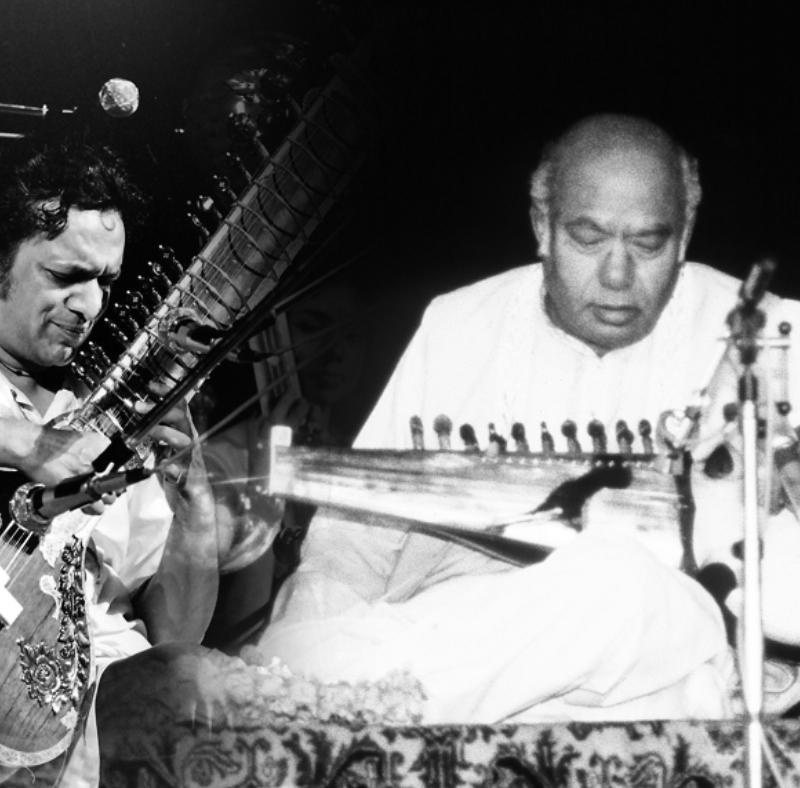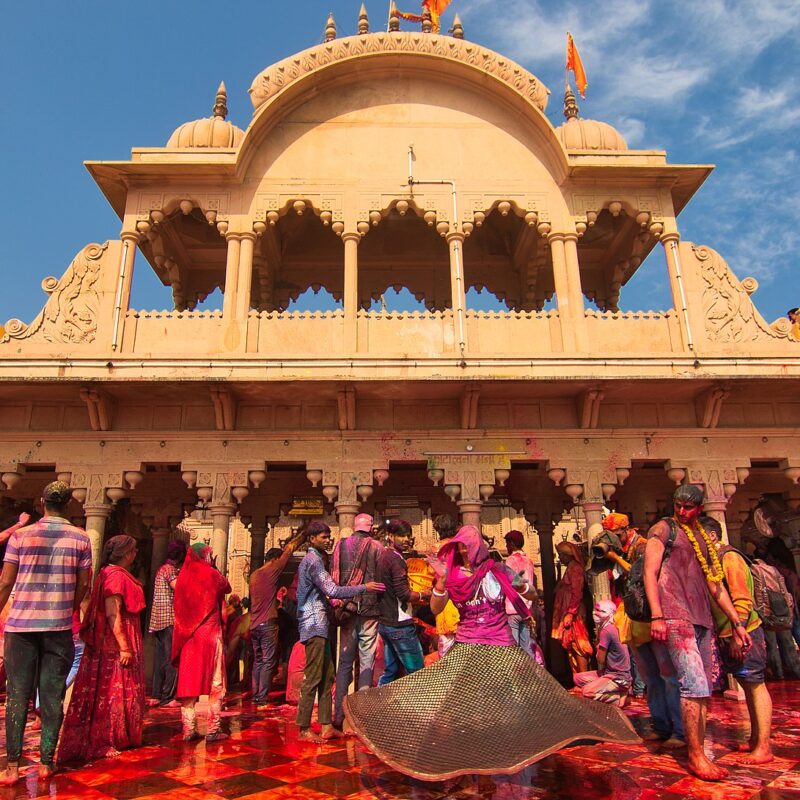
On the morning of August 13, 1965, the Jaladuta, a regular vessel of the Scindia Steam Navigation Company, departed the port of Kolkata, embarking on a month-long voyage to America.
An arduous journey that would take it across the Red Sea and Atlantic Ocean before arriving in New York Harbor, the black and weathered ship, made primarily for transporting cargo, was not built for comfort, yet still had a small passenger cabin aboard.
Though a simple space, the scanty accommodation more than sufficed for the man occupying it: A.C. Bhaktivedanta Swami, a 69-year-old renunciate who was perfectly accustomed to discipline and austerity. Carrying the bare necessities — a small suitcase, an umbrella, a bag of dried cereal lest the ship unable to facilitate his strict vegetarian diet, and a trunk of spiritual texts he had painstakingly translated into English — it mattered not that he was elderly with no prior experience outside of India. For so long he had waited for this moment. He would not take it for granted, and he would do everything in his power to not let it go to waste.
From the perspective of his many followers who came to affectionately call him “Srila Parabhupada,” the journey to this moment began at his birth, when an astrologer predicted that “at the age of 70, he would cross the ocean, become a great exponent of religion, and open 108 temples.”
From his own perspective, however, the journey’s genesis had less to do with grand prognostications, and more to do with a simple yet unflinching desire — to sincerely and wholly please his guru.
Born in Kolkata to a staunch family of Vaishnavas who worshiped Krishna as the ultimate form and source of the Divine through bhakti yoga, or loving devotion, Prabhupada was no stranger to such gurus, swamis, or sadhus (“holy people”). Throughout his childhood, his father would host at least three or four of them on a daily basis.
It was during this early period of his life Prabupada learned that dressing as a holy person didn’t actually make you one. There were many, he discovered, who were nothing more than charlatans, exploiting followers for service and adulation. A real saint, or someone who truly renounced worldly attachments in dedication to the path of spirituality, he came to realize, was actually very rare.
When, therefore, in his mid 20s, his friend Naren invited him to visit a sadhu by the name of Bhaktisiddhanta Saraswati, Prabhupada was resistant. He had seen such sadhus before, he said, and would not waste his time to see yet another.
But this one was different, Naren insisted, and was staying only a few blocks away from where they were. Prabhupada should, at the very least, meet and judge the man for himself. It wouldn’t take long.
Eventually giving into Naren’s persistence, Prabhupada reluctantly followed him to Bhaktisiddanta’s ashram, where they were escorted up to the second floor. There, amidst a group of disciples and guests, they found the sadhu sitting tall and slender, wearing the robes typical of a Hindu renunciate, which draped over his right shoulder, leaving the other shoulder and half his chest bare. With a sharp nose and discerning eyes that peered from behind round bifocals, his scholarly expression — adorned by the vertical clay marking of Vaishnava tilak donning his broad forehead — seemed to command the room with an air of immeasurable forthrightness.
Noticing the two men who, as per custom, were offering prostrated obeisances to the revered renunciate upon entering the space, Bhaktisiddhanta paid no heed to the formalities of introductory exchanges. Before they could even finish rising and find a seat, he was already addressing them.
Why, he asked, don’t they share the tradition of bhakti yoga with the whole world? They were, after all, educated young men.
Taken aback, Prabhuada could hardly believe Bhaktisiddhanta’s unabashed proposition. Without even getting to know the two men, he was already instructing them. At the same time, however, Prabhupada also couldn’t help but be impressed. As Naren previously mentioned, something about this sadhu definitely seemed different. And the fact that he wasn’t asking anything for himself, but for what he believed would benefit others, made him seem all the greater.
But being the skeptic he was, Prabhupada was compelled to speak up in challenge of the blunt edict. How, he countered, could they teach a philosophy from India, when India was still a dependent country under British rule?
Sharing the Vaishnava tradition of bhakti yoga, Bhaktisiddhanta replied in a quiet, deep voice, didn’t have to wait for a shift in rulership or politics, which are temporary and always subject to change. While a positive economic and political atmosphere is indeed important for the material well-being of all, the actual root of people’s suffering lies in the forgetfulness of their true spiritual identity.
Just as the nature of fire is to manifest light, the divine nature of every being, as everyone is part of the same spiritual family, is to manifest unconditional love. Covered by the dark clouds of self-centeredness, like lust, envy, greed, vanity, etc, so many in the world, unable to fully express the light of their true nature, are deeply suffering. Sharing a philosophy and culture by which such clouds could be dispersed, therefore, is an eternal endeavor that should be ceaselessly pursued despite the country’s governmental circumstance.

Struck by Bhaktisiddhanta’s boldness, Prabhupada and Naren listened for more than two hours, as the sadhu spoke sometimes in English, sometimes in Bengali, and sometimes in Sanskrit, quoting verses from the Bhagavad Gita (one of Hinduism’s most revered texts).
When the discourse finally came to an end, the two friends rose from their seats and graciously took their leave. Making their way down the stairs and onto the street, the hour now late, and the night dark, Prabhuapada’s mind reeled from what he had heard.
Though he was raised a Vaishnava, Prabhupada’s identity, in more recent years, had become heavily engulfed in nationalism, as he believed India, and all that it had to offer, would only be taken seriously by the rest of the world once it gained its independence. But Bhaktisiddhanta’s explanation had left a deep impression on him. Even if India was independent, the world’s spiritual plight would still be as real as ever.
Undeniably won over by the sadhu, Prabhupada, walking away from the ashram, felt his nationalist identity begin to dissipate, as a new one started forming, that of a follower of Bhaktisiddhanta Saraswati, who would dedicate his life to sharing the Vaishnava culture of love and devotion with the world.
While so convinced, he would have been ready at that point to renounce everything and assist Bhaktisiddhanta full-time in his cause, Prabhupada was both a husband and father. One day, perhaps, he could devote himself full time to teaching Krishna bhakti. Until then, he would focus on his career, make as much money as he could, and use that money to not only support his family, but also the endeavors of Bhaktisiddhanta.
In the years following their first meeting, he thus tried to do just that. And as the operator of a pharmaceutical business, he indeed experienced various levels of financial successes, allowing him to look after his family, as well as contribute to different projects Bhaktisiddhanta’s cultural and educational organization called the Gaudiya Math undertook.
But as the years wore on, his kids got older, and his business successes eventually became supplanted by one setback after another, Prabhupada sensed a force beyond himself continuously attempting to draw the curtains on his life as a worldly man.
Though he continued to do what he could to make ends meet, there was something that always seemed to curtail the pursuits of his material life, even as his spiritual one never ceased to prosper and flourish. Thus losing heart in his business endeavors, Prabhupada leaned into his spiritual aspirations, including, most importantly in his mind, attempting to fulfill Bhaktisiddhanta’s wishes, who he had since visited several more times, and officially accepted as his guru.
Now hearing of the sadhu’s failing health, Prabhupada, hoping to be given one last instruction, wrote to Bhaktisiddhanta, asking if there was some service, in particular, he could offer him in his absence.
Two weeks later, Bhaktisiddhanta wrote his reply, expressing in the letter his desire for Prabhupada to share the teachings of their great tradition with the world in English. Having recognized Prabhupada’s proficiency in the language based on his various submissions to the Gaudiya Math’s English publication, a magazine called The Harmonist, Bhaktisiddhanta was fully confident Prabhupada could carry out such a venture.
Immediately recognizing the request as being no different than the one he had received during their first meeting all those years ago, Prabhupada took the letter as confirmation of his ultimate life’s purpose. And when news reached him shortly thereafter of Bhaktisiddhanta’s passing, making the letter the last words ever conveyed to him by his guru, Prabhupada’s resolve grew all the stronger.
Realizing he would get little to no support from the Gaudiya Math, due to the conflicts that erupted within it following the passing of its leader, Prabhupada went to work on his own projects, writing an English commentary on the Bhagavad Gita, as well as starting his own English fortnightly magazine.
Eventually leaving his wife in the care of his children who were now grown up, Prabhupada retired from family life, and ultimately made his way to Vrindavan. Living there in humble circumstances, he officially accepted the renounced order of life, known as sannyasa, and engaged for several years in deep study and writing, beginning work on his magnum opus: a multi-volume translation and commentary on one of Hinduism’s most influential texts, the 18,000-verse Bhagavata Purana.
After finishing the first three volumes, Prabhupada, feeling that he now had something of real substance to offer, set his sights on America. If he was truly going to share what he believed was the world’s most important knowledge, then it made sense, he thought, for him to go to the world’s most important city — New York.
Almost 70 and practically penniless, he approached the head of the Scindia Steam Navigation Company, a lady named Sumati Morarji who was known for helping sadhus, and emphatically asked for a ticket to America. Scared the arduous trip would kill him, she initially denied his request. But Prabhupada, unwilling to take no for an answer, insisted, until she finally gave in.
Hence occupying the Jaladuta’s small passenger cabin the morning of August 13, 1965, Prabhupada began his journey to America. Suffering intense sea sickness, dizziness, vomiting, and two heart attacks in two days, the voyage truly did almost kill him. On the night of his second heart attack, however, Prabhupada dreamt of Krishna who, while rowing a boat, told him to come along, and that he had nothing to fear.
Feeling thus assured of Krishna’s protection after waking up, Prabhupada completed the trip without any further issues. The captain of the ship, in fact, said he had never before experienced such a calm Atlantic crossing.
On September 19, 1965, after a brief stop in Boston, the Jaladuta docked at a Brooklyn pier in New York Harbor, and Prabhupada, albeit in weak health, made his way off of the ship in good spirits.
Wearing a simple cotton dhoti, an old chadar, pointed white rubber slippers, and Vaishnava tilak beneath a shaved head, he stepped onto New York grounds like a man appearing from another world. Looking up at the awesome Manhattan skyline, he had no friends, no funds, and no support. He also, however, had a most powerful spiritual message, and whether people took to it or not, he knew it was his destiny to share it with them.
But, of course, people did take to it, and to astounding prophetic accuracy. Under the religious organization he went on to found called the International Society for Krishna Consciousness (ISKCON), Prabhupada, over the next 12 years, successfully gained thousands of followers, published over 80 volumes of spiritual literature, and indeed, established 108 temples.
A movement that continued and continues to blossom after his passing, ISKCON, now encompassing over 1 million followers and upwards of 800 centers around the world, is more than just a religious organization. It’s Prabhupada’s legacy of love, compassion, and service to all.
If you enjoyed this piece, then you may also be interested in reading “Who was that Hare Krishna at the start of ‘Get Back’?”












































